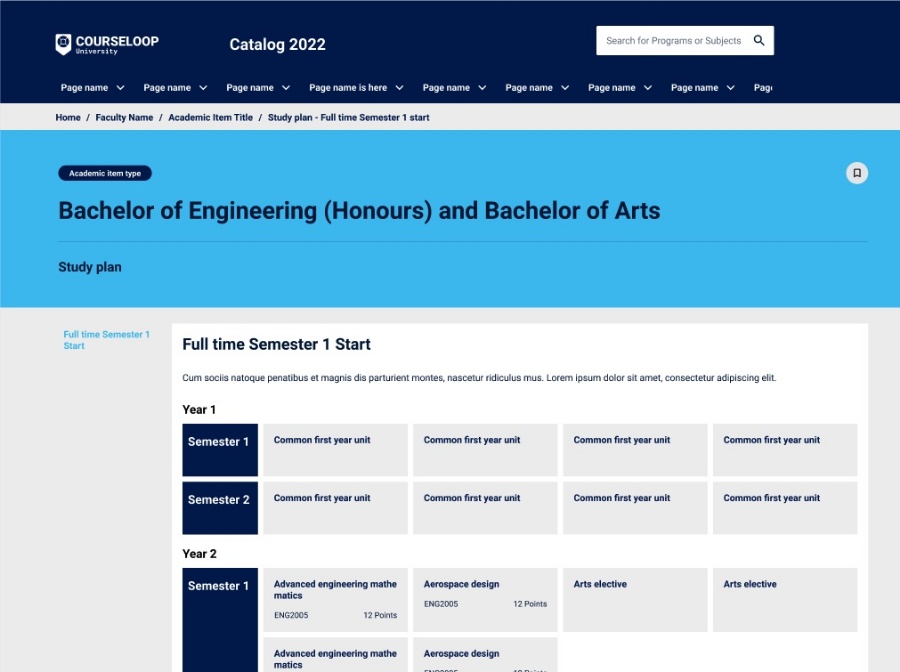
Share
How modern, interactive catalogues improve the student experience
Catalogues contain the curriculum information students need to successfully navigate and complete their chosen program of study. But not all catalogues are made equal. Using outdated methods of publishing, for example PDF or static websites, to get catalogues in front of students has its drawbacks, such as being onerous to manage and difficult to consume, which impacts student experience.
Outdated catalogues that aren’t responsive or accessible, make it hard to find the content you’re looking for, resulting in a frustrating user experience for students. Whereas modern, dynamic (interactive) catalogues are:
- Available anywhere, anytime, and on any device
- Built with accessibility in mind, meaning they support assistive technology and make content accessible to everyone
- Draw from a definitive source of curriculum information, which enables publishing to be made automatic – eliminating the need to double up on data entry, and ensures the accuracy of published information
- Easy to search and navigate, making it quick and easy for students to find the information they need
Modern, dynamic catalogues give students an exemplary and intuitive digital experience, and are an opportunity for institutions to maintain their competitive edge.
What are catalogues (handbooks)
Catalogues are the principal curriculum reference documents for those considering or pursuing post-secondary education. They contain the curriculum information students need to successfully navigate and complete their chosen program (or course) of study.
Typically, a catalogue includes information such as program completion rules, study requirements, learning outcomes, and other details like program duration, and credit point application.
Although catalog content may vary from institution to institution, their impact on students’ success is profound enough that many governments have undertaken to legislate specific types of content that must be included. They are often seen as forming part of the formal agreement between student and institution, the breach of which can be a major source of student complaint.
In addition to communicating essential curriculum information, the catalogue sets the tone for the experience a student can expect from the institution. An interactive (dynamic), digital first catalogue makes it easy for students to find and understand their study requirements which can improve enrolment, retention and completion rates. Therefore, digital catalogues serve as a powerful recruitment tool that delivers an exemplary first impression to prospective students.
Comparing outdated versus interactive catalogues
Today’s students expect a seamless user experience across all interactions with a prospective university. Despite this, many institutions are still using outdated formats such as PDFs and static websites to publish their catalogues. While these formats may have the old advantage of confining all the information to a single document, they can result in a frustrating experience for students needing to consume the information.
Nowadays the many advantages of publishing to an interactive (dynamic) online catalogues outweighs the benefit of persevering with the traditional, outdated formats. Perhaps the most important of these advantages being improvements to the students’ experience.
Why outdated catalogue publishing is problematic for students
Today’s students are digital natives who expect an intuitive, digital-first experience. They want the site to interact with them in helpful ways while they explore program curricula.Outdated catalogue formats create several problematic experiences for students. Here are some examples where they can be problematic.
- Many students want to access the catalogue online while they are on the go. In fact, 30% of visitors to CourseLoop powered catalogs do so using a mobile device. Non-mobile responsive documents and sites lead to user frustration through, for example, lack of device rendering or needing to zoom in and out, or non-resizable documents.
- Formats like PDF or outdated websites are rarely accessible. This means only a subset of students have access to curriculum information.
- Some formats take students away from the main website, which interrupts the student’s discovery experience. This can make it hard for students to navigate to other relevant information such as information on program majors (areas of study) and relevant subjects (modules), or even more general content like information about schools and faculties.
- Outdated formats make it challenging for students to find the content they’re looking for. Students want to be able to find the information they need without having to pore through an entire document. They also want to be able to navigate easily between program and module information, as well as related general information such as school policies.
- Students rely on accurate curriculum information to make informed decisions about their study and ensure they meet all completion requirements. Inaccuracies create a liability and can be a major source of student complaint. Older formats can be hard to maintain and update, which means some institutions could be risking leaving outdated information in their published catalogue, or, in some cases, become reliant on those with developer knowledge.
- Manually maintaining multiple catalogue versions across a number of years is challenging. It can be time consuming and lead to inaccurate information being published. If students cannot easily discover the right catalogue version it may result in them relying on outdated and inaccurate information. This risks the creation of negative search experience, and, in the worst case, could result in students undertaking study and accumulating debt without completing the requirements to become eligible to graduate.
Improve student and staff experience with modern catalogue publishing
Modern, dynamic catalogue publishing draws from a definitive source of curriculum information to give students accurate and up to date information in real time. It offers seamless exploration of essential curriculum information as well as relevant general content such as faculty policies.
Purpose-designed publishing software doesn’t just improve student experience, it equally benefits staff by giving them the tools they need to easily do their job better and faster.
Modern catalogues for students
With modern, dynamic catalogues, students are offered greater coverage of the information they need to succeed in an accessible, user-friendly way.
Modern catalogues:
- Offer students an exemplary user experience with an intuitive, mobile responsive – rendering on any device, and accessible interface that enhances discovery at every touchpoint.
- Make discovery simple by presenting critical curriculum information in a highly consumable format with advanced search and filtering for easy browsing and navigation. Students can also view recent pages, or save their preferred courses within the catalogues, compiling lists for later comparison.
- Maintain your institution’s brand fidelity to provide students with a seamless user experience that is uniform with the rest of your site.
- Increase visibility of contextual information by enabling the publication of things like standard study plans (program specifications), faculty policies, and links to relevant majors or subjects. This makes it easy for prospective students to explore available programs and new academic pathways that guide them to success.
- Enable on-demand access, empowering students to find accurate curriculum information relevant to them anywhere, anytime.

Curriculum publishing software streamlines how institutions develop, edit, and publish the catalogue – making it more organised, accurate and transparent.
Curriculum publishing software:
- Is purpose built with accessibility in mind, so staff don’t have to go to extra effort to make sure their technology assisted students can access all the information.
- Makes it quick and easy to update and make changes to curriculum information, eliminating risk of errors, reducing manual effort and unwanted reliance on developer knowledge for staff to do their jobs.
- Enables staff to validate data on input and set business rules to automate publishing when information is ready and approved, so that updates can be received by students in real time, while ensuring the integrity of curriculum data.
- Reduces reliance on face-to-face staff-student interactions because students can access curriculum information anywhere, at a time that works for them, and on any device.
- Enables staff to automate version control, so it is easy to keep track and ensure the right version is published to students, including the ability to track and publish multiple version instances (e.g. to cater to different offerings or calendar details). Also, versions can be archived and past versions can be made publicly available without introducing confusion over which is the current version.
- Is cloud-hosted, which means the catalogue is available any time on- or off-campus. This gives remote working staff the ability to access and make changes to the catalogue while working from home.
- Makes search engine optimisation easy. Institution’s can optimise their catalogues for prominence and appearance in search engine results pages as well as seamlessly integrate analytics tools to track and measure user traffic and other site analytics, giving you insights into user behaviour so you can see how students discover your curriculum.
- Enables staff to further contextualise students’ academic pathways by linking relevant subject information and other non-curriculum or general content, such as faculty information, as well as marketing material to your curriculum information.
“From a strategic perspective, being able to change some data at the beginning and it ripple through and immediately appear in the catalogues, which we were never able to do before, allows things like time to market to be a lot faster. And the fact that we now have a solution that renders on any device, that is properly branded – just the agility it’s giving us, and the fact that it has a sophisticated search engine to allow students to interrogate the [catalogue] is a complete change for us.”
– John Reed, Former Director of Student Services and Systems, University of New South Wales
Curriculum publishing software for online catalogues simplifies the things you need to do and makes possible the things you can’t, bringing benefit to students, staff and institutions alike.
Adopting CourseLoop enables institutions to dynamically deliver catalogues to students that are modern, accurate, and user-friendly, while cutting down the time required to retrieve the curriculum information, organise it and maintain it.

